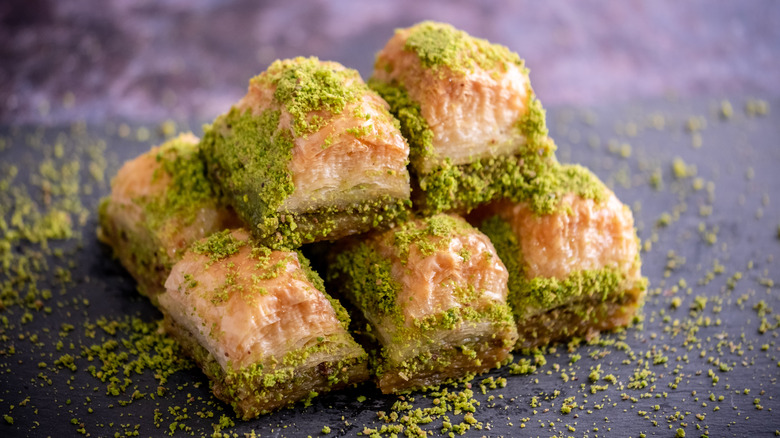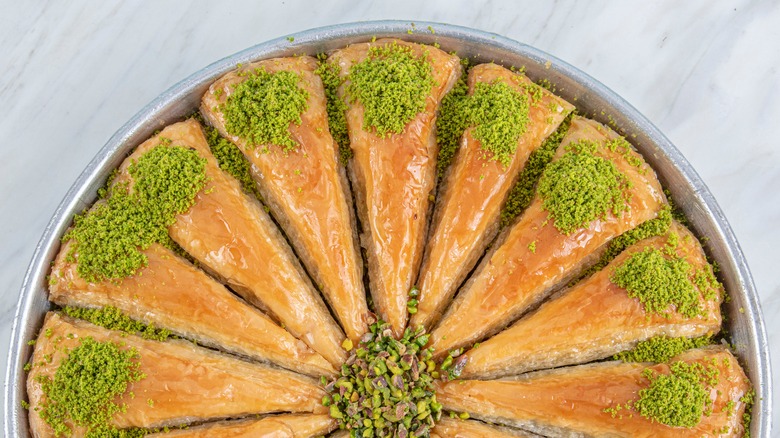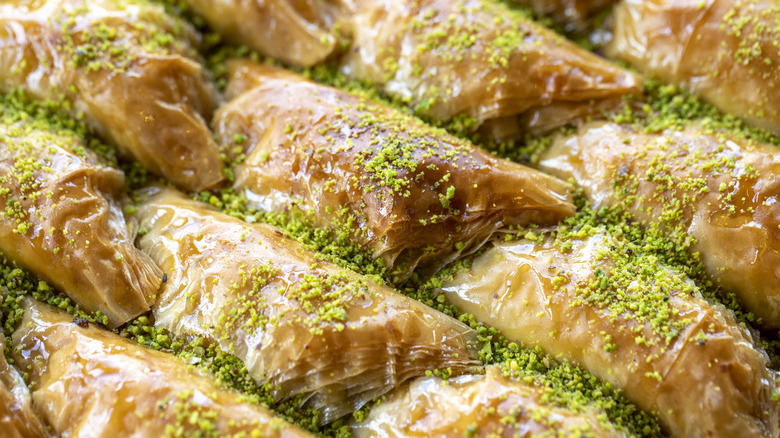The Silk Road City Known As The 'Baklava Capital Of The World'
Pistachio is arguably one of the most attractive nuts, with its startling green flesh and earthy flavor, and Turkey is one of its largest producers. With groves upon groves of trees throughout much of the country, few regions are better renowned for their produce than the Turkish city of Gaziantep. The Khoshbin Group states that in 2018, Gaziantep hosted 22 million pistachio trees alone! And with all that pistachio comes a lot of power to make baklava.
Now, if you know your way around baklava, you'll know that it can use a few different kinds of nuts to make, but the most popular kind in Turkey, and especially in Gaziantep, is pistachio baklava, characterized by their sugared, golden filo, and vibrant green filling. Baklava was originally a Turkish delicacy, but today it is enjoyed in several Mediterranean and Middle Eastern countries. Jungle Jim's explains that baklava dates all the way back to the 11th century C.E. when nomadic Turks began to layer and pleat their bread and from that practice. From there, the sweet pastry we know and love today evolved. Modern sweet baklava is sometimes thought to have been popularized by a sultan of the Ottoman Empire, Suleiman the Magnificent, and became a well-beloved treat amongst his military.
Gaziantep's Antep pistachio
The city of Gaziantep, sometimes called Aintab or Antep, which are a few of its previous titles, has a rich and long history. Located in Turkey's southeastern region, Gaziantep is one of the few places surviving today that originated under the hands of the ancient Anatolians. According to All About Turkey, the city is the beating heart of pistachio nut production in Turkey and boasts many other quality agricultural products. To truly impress upon how incredibly old and historically relevant Gaziantep is, keep in mind that the Karkamis district of the city is where the Epics of Gilgamesh were set.
Silk Road Moments claims that Gaziantep was continuously conquered by many of the great invaders throughout the ages, including Alexander the Great and the Byzantines. Eventually, it became a part of the Ottoman empire in 1516. It was a key city along the infamous Silk Road and sold much of its olive oil, wines, wheat, and, of course, pistachios. This emerald nut is why the city is sometimes referred to simply as "Antep," which is a kind of pistachio.
Antep baklavasi
Given Gaziantep's long-standing history with both pistachios and the art of pastry-making, it makes sense the city has cultivated its unique type of baklava. According to Visit Europe, Gaziantep baklava, aka "Antep baklavasi," is characterized by the traditional butter layered phyllo (filo) dough which is filled with semolina cream (which is made from durum wheat flour) and Antep pistachio (Antep fıstığı) which are heavily produced and eaten in Gaziantep. The baked pastry is then drenched in simple syrup, which crystallizes and hisses when met with the baklava right out of the oven. The Gaziantep baklava can take almost any shape, from diamonds to thin carrot slices, but they remain consistently mouth-watering.
According to the New York Times, the city of Gaziantep boasts 100 baklava shops and produces 90% of all the baklava the country of Turkey eats in a year which is no small feat! Gaziantep baklava is consumed everywhere, at holiday feasts and other celebrations, and for good reason, the city's baklava is so special to the region that it is now under the protected status of the European Union. So, if you get the opportunity to visit Turkey, take the opportunity to visit the baklava capital of the world, where you'll have a one-of-a-kind dessert you'll never forget!


